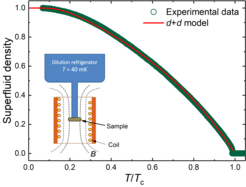Solving a new puzzle for the first heavy fermion superconductor
Heavy-fermion compounds, like high-temperature superconductors, are called quantum materials because quantum effects are the key to understanding their properties. In high-temperature superconductors, for example, conduction electrons form pairs and flow without resistance at temperatures which can be considerably higher than those required for conventional superconductivity. In heavy-fermion compounds, conduction electrons (“charge carriers”) appear to be hundreds to a thousand times heavier than a free electron.
An international team from China, Germany, the US and Canada reported novel findings on heavy-fermion superconductivity last week in the Proceedings of the National Academy of Sciences, USA (PNAS). The study focused on an intermetallic compound of cerium, copper and silicon, whose strange behaviour helped introduce the multidisciplinary field of quantum materials in 1979. In that year, Frank Steglich (then at the Technical University of Darmstadt) and a team of his former students at the University of Cologne, among them Jan Aarts (Professor of Experimental Physics at the University of Leiden, The Netherlands) and Dieter Meschede (Professor of Quantum Technology, University of Bonn, and currently President of the German Physical Society), discovered that the heavy-fermion compound CeCu2Si2 became a superconductor at very low temperatures. Surprisingly, the mechanism of superconductivity couldn't be explained by existing theory, a finding that was so unexpected and unusual that many experts in superconductivity research initially refused to accept it.
The behaviour of a superconductor is determined by the nature of the ‘glue’ holding together the electron pairs (‘Cooper pairs’). In the vast majority of superconductors, and all known before CeCu2Si2, this glue derives from the coupling of conduction electrons to the vibrations of the crystal lattice (‘phonons’). Because the superconductivity of CeCu2Si2 showed phenomenological similarities to the superfluidity of 3He, discovered a few years earlier (Nobel Prize 1996), its glue was speculated to be of magnetic origin. This was experimentally verified only in 2011, when high-resolution inelastic neutron scattering measurements were performed by Oliver Stockert from the MPI for Chemical Physics of Solids (CPfS), Dresden. The 1986 discovery by Georg Bednorz and Alex Müller from the IBM Research Center at Rüschlikon (Switzerland) of superconductivity at much higher temperatures in ceramic oxy-cuprates (Nobel Prize 1987) further enhanced the worldwide interest in the field of unconventional, magnetically-driven superconductivity.
A fundamental property of a superconductor is its energy gap, which corresponds to the energy required to destroy a Cooper pair; it is related to the Cooper-pair wave function. For a long time the energy gap of CeCu2Si2 was believed to have the same symmetry as that of the cuprate superconductors, where the gap disappears for electrons travelling along certain (‘nodal’) directions. However, recently it was found by Toshiro Sakakibara’s group at the Institute for Solid State Physics (the ISSP at the University of Tokyo, Japan, a partner institute of the MPI CPfS) that, at very low temperatures, the energy gap of CeCu2Si2 is in fact fully open everywhere, much like in conventional phonon-mediated superconductors. In consequence, the nature of the pairing was questioned, again.
Huiqiu Yuan’s team at the Center for Correlated Matter (Zhejiang University, Hangzhou, China), Lin Jiao and Frank Steglich (MPI CPfS) as well as Philipp Gegenwart (Center for Electronic Correlations and Magnetism, University of Augsburg) found a resolution to this puzzle by studying the so-called London penetration depth of CeCu2Si2 down to very low temperatures, allowing the small, fully developed energy gap to be probed. In their recent PNAS paper, a new explanation for the superconducting pair state is proposed which had been introduced earlier for Fe-based superconductors by theoreticians, and co-authors, Qimiao Si from Rice University (Houston, TX, USA), Emilian Nica (University of British Columbia, Vancouver, Canada) and Rong Yu (Renmin University, Beijing, China).

Figure 1. Superfluid density of S-type CeCu2Si2 versus reduced temperature. Red curve shows a fit of the d + d band-mixing model to the data. The superfluid density is derived from the London penetration depth. Inset demonstrates the core of the set-up for the London penetration depth measurement.
The key ingredient in this proposal relies on the fact that in the heavy-fermion superconductor CeCu2Si2 – in contrast to the cuprates – several electronic bands cross the Fermi level, i.e., it is a so-called multiband superconductor. In addition, the charge carriers within one band have the same d-wave pairing as in the cuprate superconductors, but the d-wave pairing between charge carriers on different bands is of a different symmetry. This proposal accounts for both the recent evidence of a fully open superconducting gap at very low temperatures, as well as previous experimental results which point to nodal d-wave superconductivity at slightly elevated temperatures. In d-wave superconductors, the Cooper pairs have a finite angular momentum, and in strongly correlated materials such as CeCu2Si2, there is a very strong repulsion among the charge carriers from which the Cooper pairs are formed. As a result, the angular momentum helps the charge carriers avoid each other, allowing the superconductivity to occur. This ‘fully gapped d-wave superconductivity’ in CeCu2Si2 resembles the pair state in the enigmatic B-phase of superfluid 3He, with p-wave pairing among the 3He atoms. It appears to be a model case for a wider range of fully gapped unconventional superconductors, such as the new FeSe-based superconductors and a single CuO2 layer.
This research was supported by the Sino-German NSFC/DFG Cooperation Group on Emergent Correlated Materials.
FS ; LJ / CPfS
